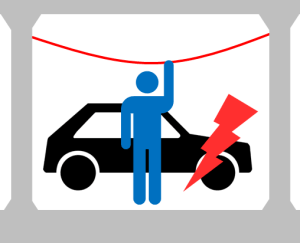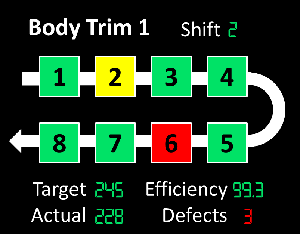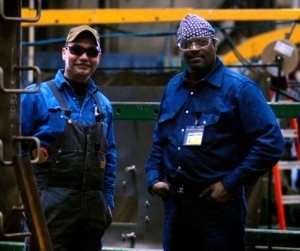 In my last post, All About Andon, I detailed how the mechanical side of an Andon signaling system works, including Andon cords, buttons, and boards. In the Western world, the mechanical side of an Andon system usually works pretty well. However, in most cases, the usage of the Andon is poor to nonexistent. Hence, in this post I tell you how to actually work with an Andon, and then I will give you a rant why companies so often mess it up!
In my last post, All About Andon, I detailed how the mechanical side of an Andon signaling system works, including Andon cords, buttons, and boards. In the Western world, the mechanical side of an Andon system usually works pretty well. However, in most cases, the usage of the Andon is poor to nonexistent. Hence, in this post I tell you how to actually work with an Andon, and then I will give you a rant why companies so often mess it up!
Quick Recap about Andons
 An Andon is a system to aid the information flow regarding the status of the production system. Operators pull a cord or press a switch if there are upcoming or actual problems. Similarly, machines and processes can send a signal if something is wrong. This information is then shown through lights, numbers, and sounds to alert others about the problems.
An Andon is a system to aid the information flow regarding the status of the production system. Operators pull a cord or press a switch if there are upcoming or actual problems. Similarly, machines and processes can send a signal if something is wrong. This information is then shown through lights, numbers, and sounds to alert others about the problems.
OK, My Andon is Blinking. What Next?
Well … get moving! A blinking Andon is a sign of a smaller (yellow) or larger (red) problem. Someone somewhere needs help, either to prevent a line stoppage or to get the line going again in case of a stop.
Who Should Help?

At Toyota, the organizational structure on the shop floor consists of small teams of four to five operators with one team leader. The operators do the actual work, and the team leader covers their bases. If someone has to take a toilet break, the team leader keeps the line working. If there is an absence, the team leader covers it (and the team leader of the next team now assists two teams). If there is time available, the team leader takes care of little things including smaller maintenance issues. And, most importantly for our Andon, the team leader is the first responder to help an operator in trouble.
Since the team leader is usually no more than fifty feet away from the operators, he can respond quickly and assist the operator even before the line stops. It may take a team leader about fifteen seconds to reach the operator, out of a typical time between cars of one to two minutes at Toyota. In many cases, the team leader prevents a yellow Andon alert from becoming a line-stopping red alert.
If the line stops completely, other operators (who have now time available) can come to assist in solving the problem. Hence, in the case of a line stoppage, there is a lot of manpower available to help fix the problem.
Depending on the type of the problem or the duration of the stoppage, others may be called in to help out (e.g., for a quick transport of material from the warehouse to get things going again).
What Happens Next?
Eventually, the line gets moving again. At Toyota, this usually happens fairly quickly. In the Western world, the problem would be considered “solved” since the line is moving again. Not so at Toyota. Getting the line moving again just fixed the symptom. The bigger goal is to solve the root cause. What caused the problem? How can we prevent it from happening again? Do we need a change or adjustment in the tools? Do we need a change in design? Do we need to update the work standards?
Again, in the Western world, there is a tendency to put a lot of engineering manpower into anything that is changed on the shop floor. At Toyota on the other hand, I regularly see quick fixes using duct tape and string (not on the cars, of course, but on the tools). They are quick to install, and they solve the problem.
When Toyota builds a new plant, the assembly line has lots of stops in the beginning. Whenever there is a problem, the line is stopped. In the first weeks, it probably stops more than it runs. However, they work continuously on fixing the causes, not only the symptoms! Within a few months, the new assembly line will work close to or at the regular legendary Toyota efficiency.

Hence the value of an Andon system lies in how you work with the system. How do you use the accelerated information flow about shop floor problems to create a lasting fix for the problems? Without that, the Andon is nothing more than an expensive disco light. Unfortunately, in the Western world, this usage is often lacking. Let me give you a rant with more details on this:
How to Mess up an Andon System
Not Stopping the Line…
 Pulling the (red) Andon cord will stop the line. This prevents problems from overflowing to the next station and allows the fixing of issues where they occur, not afterward.
Pulling the (red) Andon cord will stop the line. This prevents problems from overflowing to the next station and allows the fixing of issues where they occur, not afterward.
However, in many factories, both workers and management have been conditioned for decades that the line must not stop. Never, ever stop the line. If the line stops, we lose money. This conditioning is hard to overcome. Even though not stopping the line actually leads to more stops, there is still the mental roadblock against stopping the line to fix the problem.
If the new idea of an Andon comes around (Oooh … a Japanese word … must be good!), managers will tell their operators to pull the cord and stop the line. However, in all likelihood, operators will be hesitant to do so. And, often rightfully so. While the managers tell them to stop the line, their gut may still be against line stops. Even if they understand the benefit, the gut still thinks otherwise.

Imagine me looking at a piece of chocolate. Of course, my head tells me: “Chris, you are too fat anyway. You should not eat that chocolate …” Take a guess what happens next to the chocolate. Hint: it involves guts.
Overall, both operators and managers may be hesitant to stop the line, defeating the purpose of the Andon.
Leaving the Operator Alone with His Problems…

Above, I described you how Toyota organizes the response to help the operator in fixing the problem and addressing the root cause. Unfortunately, such a response is difficult to organize with the stretched manpower available in most Western factories. Whereas at Toyota there is one team leader for every four to five operators, in many Western plants the first responder has to cover twenty to thirty operators or more. And this is on top of all the other issues and problems he has to take care of, from ERP system paperwork to restocking the coffee machine.
Simply speaking, nobody has time to help the operator! If this happens a few times, the operators will quickly learn that there is no point in pulling an Andon cord; it is easier to simply push the problem downstream.
Not Thinking Things Through…
Often, higher-ups decide they need an Andon to have a better performance, since Toyota has them, and … you know … the power of Japanese words in manufacturing … and stuff … Oh, and it has to happen yesterday at the latest!

I have seen lots of money and time wasted on expensive Andon systems that nobody wanted, nobody had time to think through, and nobody ever looked at. For example, the $30,000 multiple large monitors under the ceiling that were never turned on because the workers’ representatives objected. For example, the nice large LCD displays in every team meeting corner (about eighty altogether in the plant), which I have not seen used in two weeks on the shop floor. For example, the many lines where the operators quickly learned that they are not really supposed to stop the line but rather to push the problem downstream (because that’s what the reaction of the managers taught them, even though the managers said otherwise).
Summary
The value of an Andon system is in using it! Like most other lean ideas, the implementation is more than putting up some lights, boards, or cards; it instead requires changing the way we work. Putting up some cords and lights only gives you information. It is up to you to act on it. Failure to use the information will not improve your system – no matter how fancy the Japanese name is.
As always, I hope this post was insightful, and I look forward to reading your comments here or on LinkedIn, Twitter, or elsewhere. No go out, fix a problem, and organize your industry!

Hello Christoph. This is Carlos, process engineer and someone loved of opertional management from Spain. First of all, I would like to show you my admiration about your operational and industrial knowledge. It is amazing how simple you can explain tecthnical topics. If people read carefully everything you expose in your posts, they would learn more than making a master degree. And of course, it would be cheaper, lol. Thank you very much for you useful information. Please, receive all my support to keep sharing your experiences and knowledge.
Carlos S.R
Hello Carlos, many thanks for the compliments. Please keep on reading 🙂
Hi Christoph!
Nice reading, -93 i was testning the Andon system live as Andon operator in the Saab Automobile for 13 weeks in on departement wih great success.
The whole Andon concept was 100% introduced -94 in press, body, paint an final assembly.
However we only tested the Stop function but all issues reported was notified and corrective actions requested i.e. Root cause and corrective actions.
Saab was starting with the Lean Concept taken from Toyota -86. Saab eventually win the Swedish Lean award in 2009.
Thanks, Anders. Glad you liked my article 🙂 From your description I assume the corrective action worked, congratulations! As per my article, this is where the Andon fails most often.
Hi Christoph! Great Article, I’m in the process of implementing Andon System Visual/Audio in my Facility, and I’m dealing with all the things you mentioned in your post. By the way we are adopting your slogan “Keep Calm and Stop the Line”, if not “No problem is a problem”. Regards!
Hi Edgar: Cool! I used the original poster https://commons.wikimedia.org/wiki/File:Keep-calm-and-carry-on-scan.jpg , but if you need higher resolution I recommend the vector graphic https://commons.wikimedia.org/wiki/File:Keep_Calm_and_Carry_On_Poster.svg. Both are public domain. The font is not exactly but close enough to Gill Sans MT.
Best wishes, Chris
Hi everyone,
Normally I’ve seen the Andon system is used only to show information at the time and some cases where they use it to get assistance.
In both cases never get a real efficient solution if we analyze the fact you mentioned: Nobody gets interested on root cause identification but only on problem solving.
I find this very interesting to change the organization culture to use this tools correctly, thanks for the article.
Regards
Hi Daniel, as you said, the installation of the hardware is usually the easy part.Using it is the more difficult step. Thanks for commenting 🙂
I agree with your observations. Lacking the courage to stop the line is certainly not the answer. People need leadership and not management. A management thought process is to just keep using the current state process and pass the less than acceptable results downstream as you state.
In regard to this subject, OEE Overall Equipment Effectiveness systems are on the market and they do assist with identifying what is actually happening real time on the shop floor. What is your opinion on these systems and do they really help resolve shop floor issues quicker and find root causes and proactive solutions, since they are in a real time reporting mode?
Hi Dennis, I am always wary about managing a shop floor based on data only. It is easy to generate a lot of data, but there is no “killer app” yet which uses the data well. Think “internet before google and youtube“. Often, data is also very unreliable (see Top Three Methods on how to Fudge Your OEE and Lies, Damned Lies, and KPI).
Most importantly, though, I am a firm believer of GoToGemba: Visit the shop floor!. Data can help, but there is so much information that is not visible in mere data.
So, digital systems are at best a support for other things, but still way too unreliable on its own. Hope this helps, Chris.
Hi Christoph, great post about Andon. How do you like modern “digital” implementations about andon? e.g. with smartphones or wearables? I have written a piece about using a smartwatch for andon https://workerbase.com/how-to-build-an-andon-app/
Best regards, Thorsten